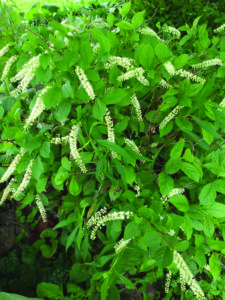Little Henry makes a big impact

There are many cultivars of sweetspire, but I’m going to talk about my favorite, Little Henry, whose compact size of 24 to 36 inches tall with a 36-inch spread and low mounding habit, make it and excellent choice for your landscape.
Its compact size is perfect for mass plantings in your flower beds or as a border. It will also work when planted in a large container to grace your patio or deck.
Commonly known as Virginia willow or Virginia sweetspire — scientific name Itea virginica — sweetspire belongs to the saxifragacas family. The name itea comes from the Greek word meaning willow as it grows well in moist fertile soil, but once established, can be drought tolerant. It is rated for Zones 5 to 9 and hardy to minus 20 degrees.
The Little Henry variety is not only deer-resistant, drought-tolerant and a source of nectar for pollinators, but you’ll enjoy the low-maintenance, attractive, three-season interest.
In May and June, your shrub will be covered in a blanket of 3- to 4-inch long, gracefully arched, scented catkin-like spiers. These catkins give the shrub its common name of sweetspire. These blossoms are a magnet for bees and butterflies.
During the summer months, its dark green foliage is a great background to highlight any plantings you have in front of them.
Come fall, the foliage puts on its display of bright orange to red color. This is an excellent replacement for the burning bush, an invasive species.
Sweetspire grows well in all light conditions from full sun to full shade. When planted in full sun, your fall color will be brighter. The growing habit will be more upright in the shade while branches will become more arching in the sun.
One-third of the older growth can be pruned to the ground each year after flowering. Do not prune in early spring or you’ll lose the current season’s flower buds.
Little Henry compact size allows you to plant near your deck or patio so you can fully enjoy the fragrant flowers.
The only problems or pests the sweetspire may encounter may be aphids or leaf spot, but these are infrequent. Best to fertilize in the spring with a granular formulated for trees and shrubs.
To learn to grow these (easy!) and for more details, go to http://go.osu.edu/sweetspire.
Baytos is an Ohio State University Mahoning County Extension Master Gardener Volunteer.

